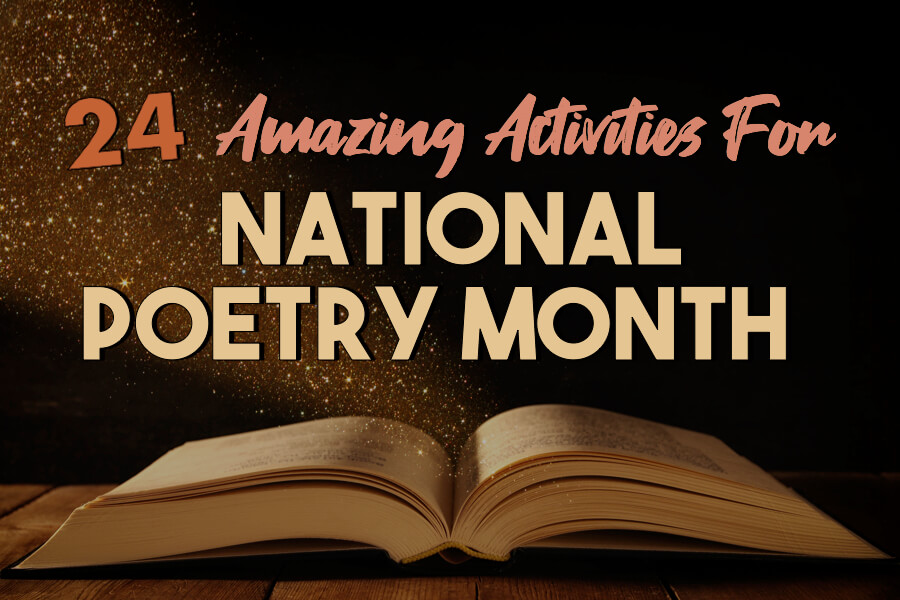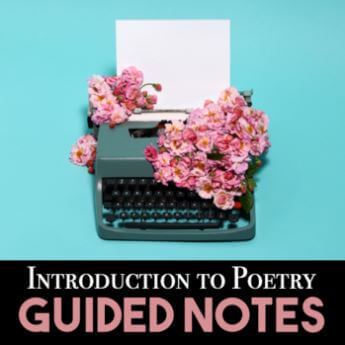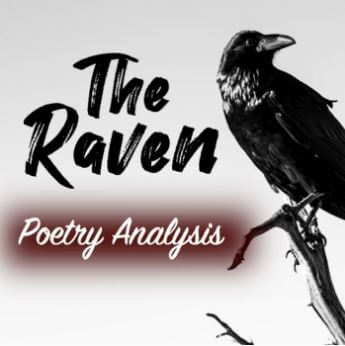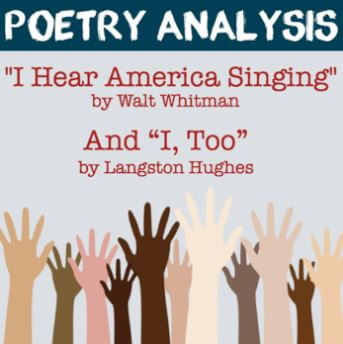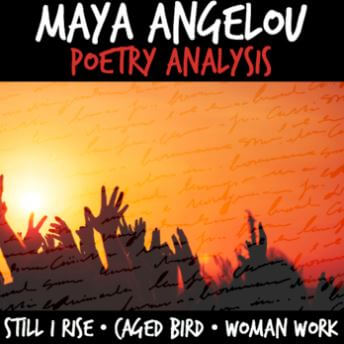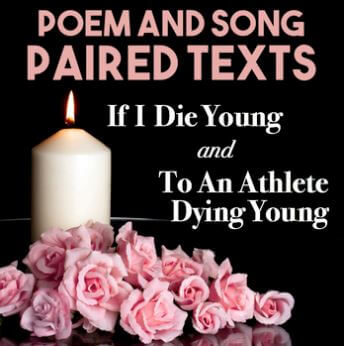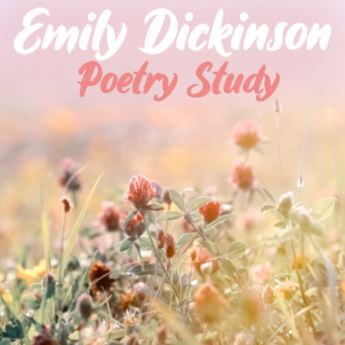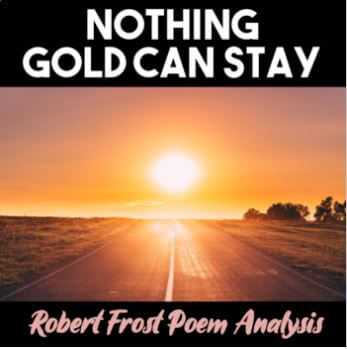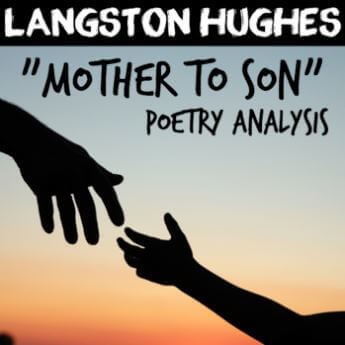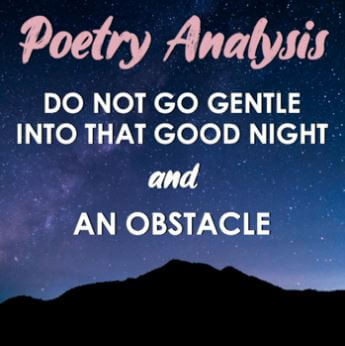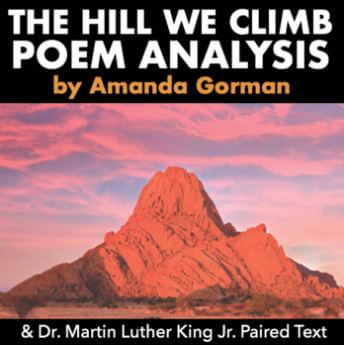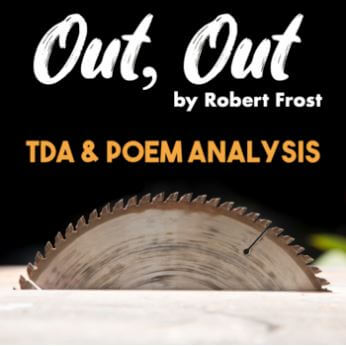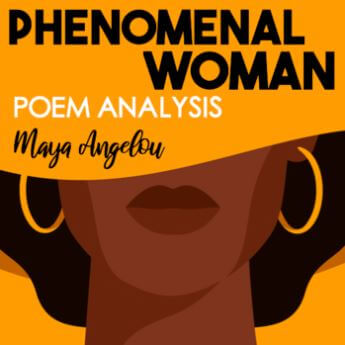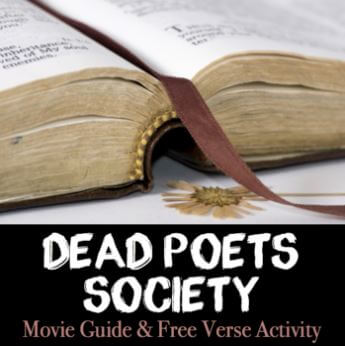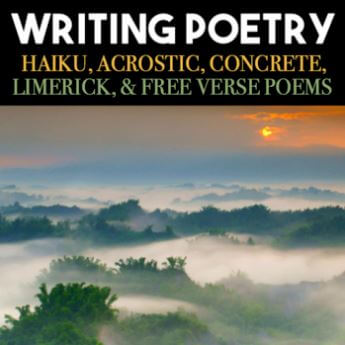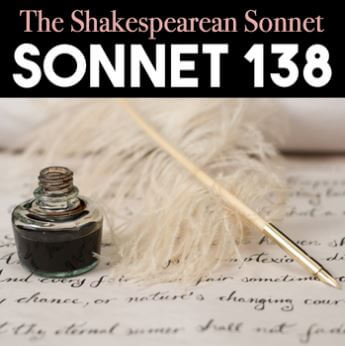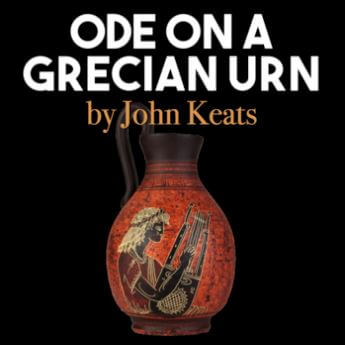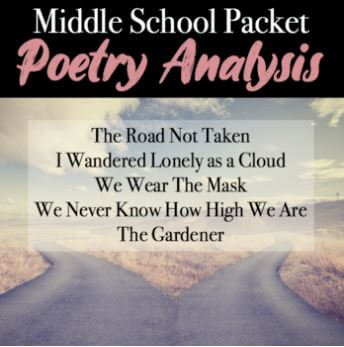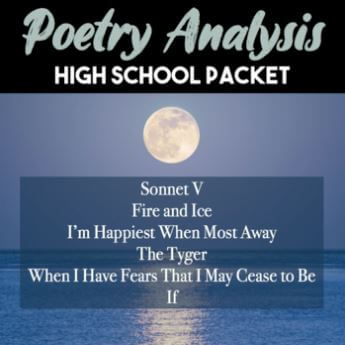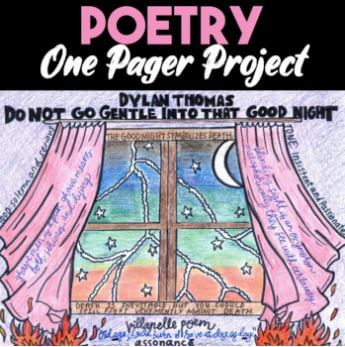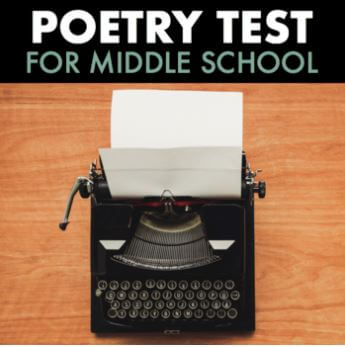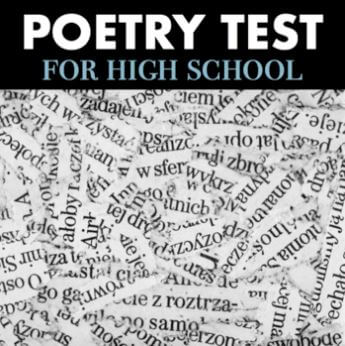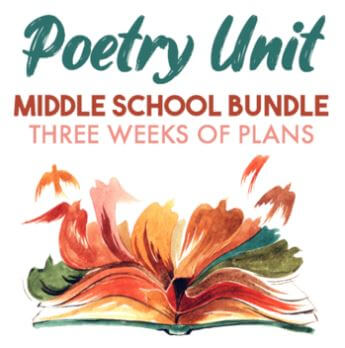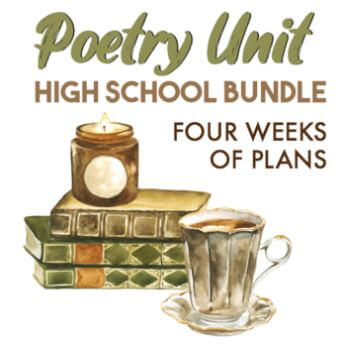Teach your students what a poem is as well as all the important information necessary while teaching poetry, like: vocabulary, sound devices, types of poetry, figurative language, how to analyze a poem, and how to find rhyme scheme.
In this resource, you will receive a packet of graphic organizers/guided notes along with a Powerpoint lesson that teaches the following terminology:
VOCABULARY
poem, speaker, line, stanza, quatrain, couplet, cinquain, tercet, refrain, symbol, theme, mood
tone, imagery, juxtaposition, oxymoron, pun, paradox, allusion, proverb, foot, iamb, iambic pentameter, enjambment, anaphora, metonymy
FIGURATIVE LANGUAGE
simile, metaphor, personification, idiom, hyperbole, irony
SOUND DEVICES
rhyme, rhyme scheme, slant rhyme, rhythm, meter, alliteration, consonance, assonance, onomatopoeia, repetition
TYPES OF POETRY
narrative, lyrical, haiku, ballad, sonnet, limerick, free verse, acrostic, concrete, blank verse, blues poem, elegy, ode, prose, villanelle
HOW TO ANALYZE A POEM
HOW TO DETERMINE RHYME SCHEME
This resource includes a copy of the poem “The Raven” by Edgar Allan Poe and 26 close reading questions. The analysis includes an in-depth look at academic vocabulary, poetic devices, and literary elements in the poem. (An answer key is also provided.)
Poetic and Literary Devices Covered in this Activity:
- allusion
- alliteration
- symbolism
- rhyme scheme
- repetition
- mood
- tone
- imagery
- gothic literature
- theme
This purchase includes an individual poetry analysis of the two poems, “I, Too” by Langston Hughes and “I Hear America Singing” by Walt Whitman. Between these two poems, students will address: tone, repetition, rhythm, theme, allusion, symbolism, alliteration, and irony.
Students will then answer a constructed response question that requires them to reflect on both poems as well as their own personal experiences.
Students LOVE reading and analyzing Kobe Bryant’s “Dear Basketball” Poem. In this activity, they will complete a Poem Analysis & Compare/Contrast Paired Text Activity. The paired text students will look at is Michael Jordan’s 2003 Retirement Letter, also titled “Dear Basketball.”
In 2015, Bryant announced his retirement through “Player’s Tribune” in a poem titled “Dear Basketball.” In the poem, Bryant shares his love for the sport with the world. Bryant later earned an Academy Award for Best Animated Short Film for “Dear Basketball” in 2018.
Included in this lesson:
- Anticipation Guide
- “Dear Basketball” poem by Kobe Bryant, analysis and answer key
- Paired Text Excerpt of Michael Jordan’s letter: questions and answer key
- After Reading Poem — Creative Writing Activity
Perfect for Women’s History Month or Black History Month!
This purchase includes:
- An introduction to the life of Maya Angelou
- Analyses of Angelou’s three poems: Still I Rise, Caged Bird, and Woman Work
- A constructed response question which requires students to compare and contrast two of the three poems based on theme, imagery, tone, language, style, mood, or the influence of Angelou’s life on her work
- Sentence starters for struggling writers to write the text-dependent analysis paragraph
The analyses questions cover important poetic devices including: simile, tone, alliteration, rhyme scheme, speaker, repetition, imagery, personification, juxtaposition, universal theme, stanzas, and mood.
In this poetry analysis activity, your students will read and answer questions regarding the famous poem “To an Athlete Dying Young” by A. E. Housman. Next, your students will listen to the song “If I Die Young” by The Band Perry that carries a similar message. Then, students will take a closer look at how these two texts relate. Comparing and contrasting these paired texts will help your students better understand point of view, tone, mood, and theme!
Add music to make poetry fun for students!
This resource includes:
- Full text of the poem “To an Athlete Dying Young” by A. E. Housman
- Analysis questions for the poem “To an Athlete Dying Young”
- Song analysis questions based on the lyrics “If I Die Young” by The Band Perry
- Compare and contrast question about the song and poem
- EDITABLE copy of the questions so you can make modifications if needed
- ANSWER KEYS for everything
In this Emily Dickinson poetry study, students will analyze three poems as well as a short biography of Emily Dickinson; then they will compare and contrast the author’s techniques and poetic devices used in each poem.
Emily Dickinson is one of America’s greatest poets of all time, writing during the Romantic Era of American Literature. Have your students analyze how Dickinson takes an abstract feeling or idea in her poetry and correlates it to something physical.
The literary analysis questions in this lesson are in reference to the following 3 poems:
- “It’s All I Have to Bring Today”
- “Hope is the Thing with Feathers”
- “Because I could not stop for Death”
Students will write a constructed response using textual evidence to compare and contrast two of the three poems.
Literary and Poetic Devices covered:
- personification
- alliteration
- theme
- mood
- tone
- imagery
- symbolism
- language
- style
- repetition
- irony
- metaphor
- extended metaphor
- consonance
This lesson is a poem analysis of “Nothing Gold Can Stay” by Robert Frost. This is a perfect side activity for the novel The Outsiders by S. E. Hinton!
This activity also works on its own if you are looking just to teach about the poem itself. Your students don’t have to be reading The Outsiders.
In Chapter 5 of The Outsiders, Ponyboy recites the poem “Nothing Gold Can Stay.” This poem plays a major role in the novel as it represents the universal message to stay gold and stay pure. Have your students analyze the poem and build their comprehension; it will make analyzing the theme of the book much easier later on! The poem analysis will touch on important literary elements such as: rhyme scheme, tone, theme, metaphor, alliteration, allusion, imagery, and personification.
To enhance their learning and make the lesson more engaging, students will also study a poem with a similar theme. Students will listen to the Bob Dylan song, answer the questions, analyze the lyrics, and then compare and contrast the themes present in both texts.
With this lesson, students will do brief research on the background and life of famous Harlem Renaissance author Langston Hughes. Included are six questions about Hughes that students must answer.
Student will then read the poem, “Mother to Son.”
Also included in this product are ten close reading questions to help students analyze the poem/song. Important poetic and literary devices covered in this lesson include:
- metaphor or extended metaphor
- tone
- anaphora
- dialect
- universal theme
- historical context
- author’s background and influence on the text
In this Paired Texts Poetry Analysis, your students will analyze the two poems: “An Obstacle” by Charlotte Perkins Gilman & “Do not go gentle into that good night” by Dylan Thomas.
This resource includes:
- Full text of “An Obstacle” by Charlotte Perkins Gilman (Due to copyright law, I am unable to provide a full text of the poem “Do not go gentle into that good night” by Dylan Thomas)
- Graphic Organizer that closely examines both poems for: meaning, tone, figurative language, setting, imagery, and theme (PDF)
- Answer key for poem analyses
- Constructed Response task which requires students to develop an answer in paragraph form. (The first CR question asks students to compare the themes in each poem. The second CR question requires students to personally connect with the theme.)
- Editable copy (word document) of the poetry analysis graphic organizer
In this lesson, students will analyze Amanda Gorman’s poem “The Hill We Climb” as well as Dr. Martin Luther King Jr.’s powerful speech “I’ve Been to the Mountaintop.”
On January 20, 2021, Amanda Gorman touched the American people when she delivered her poem “The Hill We Climb” at the presidential inauguration. Let your students be a part of her powerful message. Amanda Gorman is the youngest inaugural poet in US history. Students will also read an excerpt from Dr. Martin Luther King, Jr.’s “I’ve Been to the Mountaintop” speech. This speech was delivered April 3, 1968 in Memphis, Tennessee, the evening before Dr. Martin Luther King, Jr. was fatally shot at the Lorraine Motel on April 4, 1968.
This is a great activity to reflect on current events as well as the Civil Rights Movement. Both speeches are connected and make a great paired texts lesson. Have students complete a close reading of both speeches, then compare and contrast themes, tones, and historical contexts. Analysis questions and answer keys are included. Poetic devices highlighted in this lesson include: tone, theme, alliteration, anaphora, idiom, and metaphor.
In this Poem Analysis and TDA Essay (Text Dependent Analysis), students will first read and answer questions for the poem “Out Out—” by Robert Frost. Students will then write a TDA based on themes and figurative language in the poem.
In this lesson plan:
- Full Poem “Out Out—” by Robert Frost (1916)
- Poem Analysis Questions that concentrate on poetic devices (alliteration, allusion, theme, mood, tone, dialogue, connotation, rhyme scheme, juxtaposition) with ANSWER KEY
- TDA Text Dependent Analysis Prompt and worksheets for writing
- TDA Prewriting, planning, brainstorm Graphic Organizer for Students
- TDA Rubric and Grading guidelines based on: content, focus, organization, style, and conventions
This purchase includes the study of Maya Angelou’s famous poem: Phenomenal Woman.
Students will read Angelou’s poem through twice and then answer the analysis questions. Students will cover important poetic devices, including:
- rhyme
- rhyme scheme
- consonance
- repetition
- figurative language
- metaphor
- alliteration
- hyperbole
- tone
- audience
- theme
Answer key is included.
This is a great activity for students studying poetry or to incorporate during Women’s History Month or Black History Month.
As your students watch the 1989 Film Dead Poets Society (directed by Peter Weir), have them answer these film analysis questions to help them better comprehend and understand the film’s meaning and purpose. Additionally, have them personally connect to the theme of the film by writing their own free verse poem in response to Walt Whitman’s poem “O Me! O Life!” The film is 2 hours and 8 minutes in length.
Included in this lesson:
- 22 Comprehension and Analysis questions based on the film “Dead Poets Society” — these questions require students to connect to the characters in the film and use inferencing skills
- Answer key to the film’s analysis questions
- Free Verse Writing Activity: prompt and rubric in response to Walt Whitman’s poem “O Me! O Life!”
- Editable copy of the lesson for teachers to make modifications if needed
Students will write their own original poems with this lesson and activity created for middle school students (6th, 7th, 8th, or 9th grade).
Make writing poetry fun for students by giving them choice! Students will first learn about five different types of poems. Then, they will choose 3 of the 5 poems they’d like to write. Students will write their rough drafts in a packet, and then finalize their work on blank pieces of paper which result in beautiful wall art for your room.
In this ELA resource, you will receive:
- Powerpoint presentation that includes examples and definitions of the following 5 types of poems: Haiku, Acrostic, Concrete, Limerick, and Free Verse
- Student packet that includes: directions, requirements, and examples of all 5 poems
- An example final draft of a limerick with colored illustration
Teach your students all about Sonnets with a unique analysis of William Shakespeare’s Sonnet 138.
1) First, use the Powerpoint presentation to familiarize your students with:
- Sonnet definition and structure
- Shakespearean Sonnets
- Petrarchan Sonnets
- Spenserian Sonnets
- Miltonic Sonnets
- Iambic pentameter
- Volta
- Two-part thematic Structure
- Rhyme Scheme
Guided notes worksheet included!
2) Then, have your students analyze Shakespeare’s Sonnet 138 by answering comprehension and literary analysis questions. Answer key included!
3) Lastly, have your students write their own original Shakespearean Sonnet. Directions and guidelines included.
Teach your students all about Blackout Poetry with this fun lesson and activity!
In this resource, you will receive:
- Teacher Guide
- Powerpoint lesson on Blackout Poetry with step by step directions for students to create their own blackout poems in a variety of ways
- 10 Examples of blackout poems
- 40 Pages of printable texts your students can use to make their own poetry
- Editable word document Rubric and Prompt for students
Students will read and analyze the famous poem by John Keats, “Ode On A Grecian Urn.” This resource is great for any poetry unit!
This lesson includes:
- Full text of the poem “Ode On A Grecian Urn”
- 14 Questions about the poem: a mix of comprehension and literary analysis questions
- Answer key
- Write Your Own Ode Poem Activity for Students (Directions and Requirements)
- EDITABLE Word Document so you can make modifications if you wish to
This Poetry Packet includes 5 Poems your students will read and analyze. The poems included are suggested for a Middle School Poetry Unit: 7th, 8th or 9th Grade ELA.
This packet is a wonderful tool because you can have students complete the analyses of the poems in a variety of ways: whole-class, independently and/or collaboratively.
The poems included in this packet are:
- “The Road Not Taken” by Robert Frost
- “I Wandered Lonely as a Cloud” by William Wordsworth
- “We Wear The Mask” by Paul Laurence Dunbar
- “We Never Know How High We Are” by Emily Dickinson
- “The Gardener” by Robert Louis Stevenson
In this packet, students will work on poetry skills such as: rhyme scheme, rhyme, allusion, imagery, assonance, consonance, alliteration, hyperbole, theme, tone, mood, author’s purpose, personification, and connotation.
In this High School Poetry Packet, your students will read, study, and analyze six famous poems! Perfect for any Poetry Unit!
This packet is a wonderful tool because you can have students complete the literary analysis questions in a variety of ways: whole-class, independently, or collaboratively.
The 6 poems included in this packet are:
- Sonnet V by Shakespeare
- “Fire and Ice” by Robert Frost
- “I’m happiest when most away” by Emily Brontë
- “The Tyger” by William Blake
- “When I have Fears That I May Cease to Be” by John Keats
- “If” by Rudyard Kipling
In this packet, students will work on poetry skills such as: rhyme scheme, rhyme, imagery, assonance, consonance, caesura, anaphora, alliteration, theme, tone, mood, personification, enjambment, connotation, and more.
Your students are going to love this Poetry Digital Escape Room! Students will read and analyze the poem “Stopping by Woods on a Snowy Evening” by Robert Frost.
They will solve puzzles in this peaceful scene of snowy woods, glistening mountaintops, and a beautiful, serene frozen lake. In this 360° digital escape room, students will try to escape the woods before the sun goes down! This activity is designed to work for a laptop, tablet, or smart phone.
This game requires reading comprehension strategies, knowledge of poetic devices, and critical thinking skills. Watch the preview video and see exactly what’s inside the digital escape room!
Included in this download are teacher instructions, student instructions (digital), the master lock graphic organizer, answer keys, the full text of the poem, and a reflection sheet (optional).
PLEASE READ: While using this resource, you must have a wi-fi connection and the ability to access the following sites: Google Forms and Kuula.co. Please check that these websites are not blocked by your district’s filter before purchasing. Your students do not need to have a Google account.
Assign your students a one pager poetry analysis project and have your students share their understanding of ANY POEM by imaginatively blending their written ideas with colorful images from the text. You can pick one poem for your whole class to use or have all your students pick their own individual poems! Students’ artwork make for unique and creative analyses of the literature and also make great bulletin boards!
Included in this purchase is:
- Student directions for the one pager project
- Rubric for the one pager project
- Example one pager (based on the poem “Do Not Go Gentle Into That Good Night” by Dylan Thomas)
- 10 BLANK TEMPLATES (printable — optional)
- EDITABLE word document so teachers can modify instructions or rubric
Students are encouraged to include several of these literary devices, poetic devices (sound devices), and figurative language elements into their final projects: metaphor, simile, personification, hyperbole, imagery, pun, oxymoron, paradox, idiom, allusion, symbolism, assonance, consonance, alliteration, anaphora, rhyme, rhyme scheme, repetition, onomatopoeia, cacophony, mood, tone, and theme.
This resource includes a Poetry Assessment for upper middle school students (7th, 8th, or 9th grade ELA). You will receive a printable PDF copy as well as an EDITABLE word document in case you would like to make modifications. A detailed answer key is also included!
The format of this test includes:
- 8 fill-in-the-blank questions with a word bank
- 6 matching questions with poem types
- 5 matching questions with sound devices
- 5 matching questions with figurative language
- A poetry analysis of two poems: “There Will Come Soft Rains” by Sara Teasdale and “Nature” by Henry Wadsworth Longfellow
- Students will answer 5 multiple choice questions regarding each poem
- 1 constructed response where students will compare the themes of each poem in a fully developed paragraph
(35 questions in total)
The Poetry Test covers the following terms:
rhythm
mood
theme
poem
tone
allusion
imagery
rhyme
narrative poem
lyrical poem
haiku
acrostic poem
limerick
free verse
repetition
alliteration
assonance
consonance
onomatopoeia
personification
hyperbole
idiom
simile
metaphor
symbolism
This resource includes a Poetry Assessment for high school students (9th-12th grade ELA). You will receive a printable PDF copy of the test as well as an EDITABLE word document in case you would like to make modifications. A detailed answer key is also included!
The format of this test includes:
- 10 fill-in-the-blank questions with a word bank
- 8 matching questions with poem types
- 5 matching questions with sound devices
- 7 matching questions with figurative language
- A poetry analysis of two poems: “A Psalm of Life” by Henry Wadsworth Longfellow and the Sonnet “Death, be not proud” by John Donne.
- Students will answer 5 multiple choice questions regarding each poem
- 1 constructed response where students will compare the themes of each poem in a minimum of two fully developed paragraphs
(41 questions in total including the written response)
The Poetry Test covers the following literary terms:
rhythm
mood
theme
poem
tone
speaker
allusion
symbol
imagery
rhyme
narrative poem
lyrical poem
free verse
sonnet
villanelle
ballad
ode
elegy
alliteration
assonance
consonance
onomatopoeia
personification
hyperbole
idiom
simile
metaphor
paradox
oxymoron
theme
This resource is a FULL POETRY UNIT for ELA grades: 7th, 8th, or 9th! You will get a collection of different lessons, activities, and projects, plus a TDA essay, digital escape room, and final test! I’ve also included an example schedule for teachers to follow day-by-day!
Included in this middle school poetry unit bundle:
- Introduction to Poetry Lesson & Guided Notes
- Kobe Bryant “Dear Basketball” Poem & Paired Text Michael Jordan Letter
- “Nothing Gold Can Stay” by Robert Frost Poem Analysis and Paired Song
- “Out Out” by Robert Frost Poem Analysis and TDA Essay
- Writing Poetry/Writing Workshop: Haiku, Concrete, Acrostic, Limerick, Free Verse
- Blackout Poetry Lesson and Project
- Poetry Packet — 5 Poems to Analyze
- Poetry Digital Escape Room — Robert Frost Poem Analysis & Comprehension Game “Stopping by Woods on a Snowy Evening”
- Poetry One-Pager Project and Poem Analysis for ANY POEM
- Editable Poetry Test/Assessment for 7th, 8th, or 9th Grade Poetry
- Teacher guide with day by day schedule for 3 weeks of Poetry
This bundle is so diverse and your students will get to analyze at least 12 different poems!
Included in this high school poetry unit bundle:
- Introduction Poetry Lesson & Guided Notes
- The Raven by Edgar Allan Poe Poem Close Reading
- To an Athlete Dying Young by A. E. Housman & Song Comparison Activity
- Do Not Go Gentle Into That Good Night & An Obstacle Paired Texts Analysis
- Dead Poets Society Movie Guide & Free Verse Poem Writing
- Sonnet 138 William Shakespeare, Sonnet Lesson & Writing Activity
- Ode On A Grecian Urn | Poem by John Keats & Ode Writing Activity
- Blackout Poetry Lesson and Creative Art Project
- Poetry Packet: Analysis of 6 Poems
- Poetry Digital Escape Room using Robert Frost Poem
- Poetry One-Pager for ANY POEM
- Editable Poetry Test with Answer Key
- Teacher guide with day by day schedule for 4 weeks of Poetry
